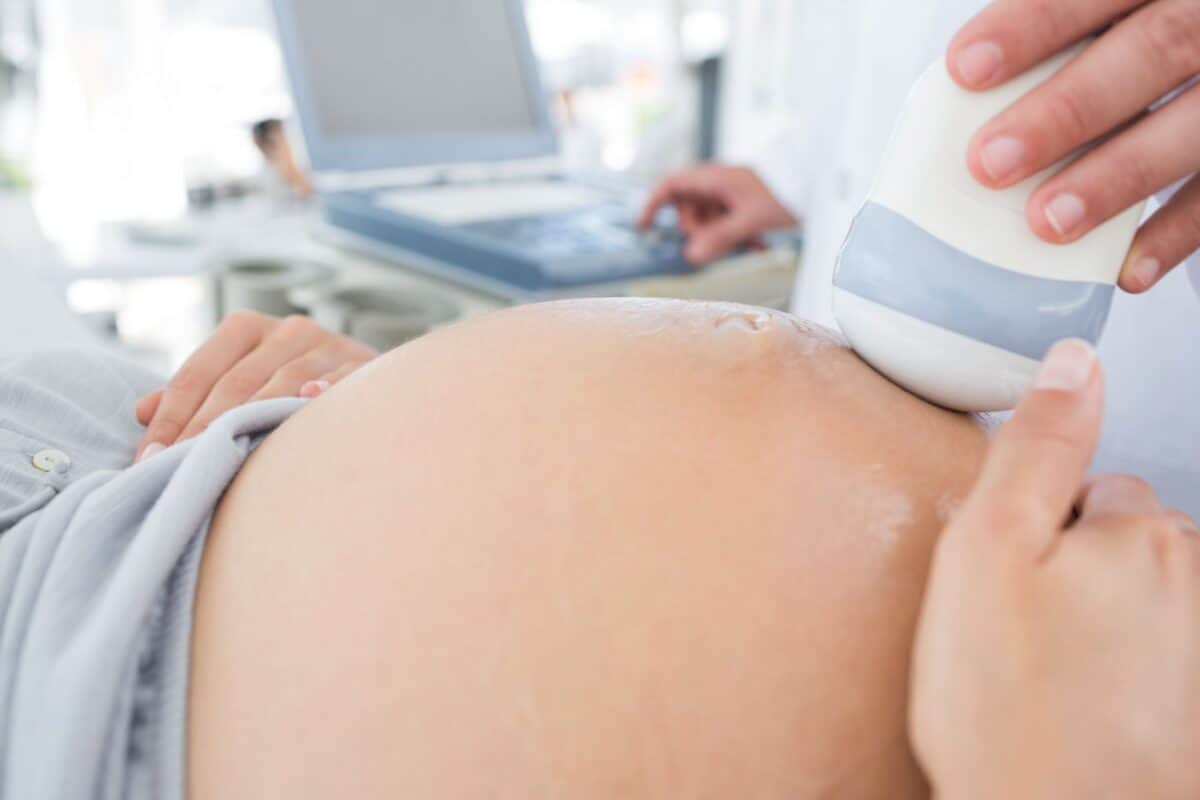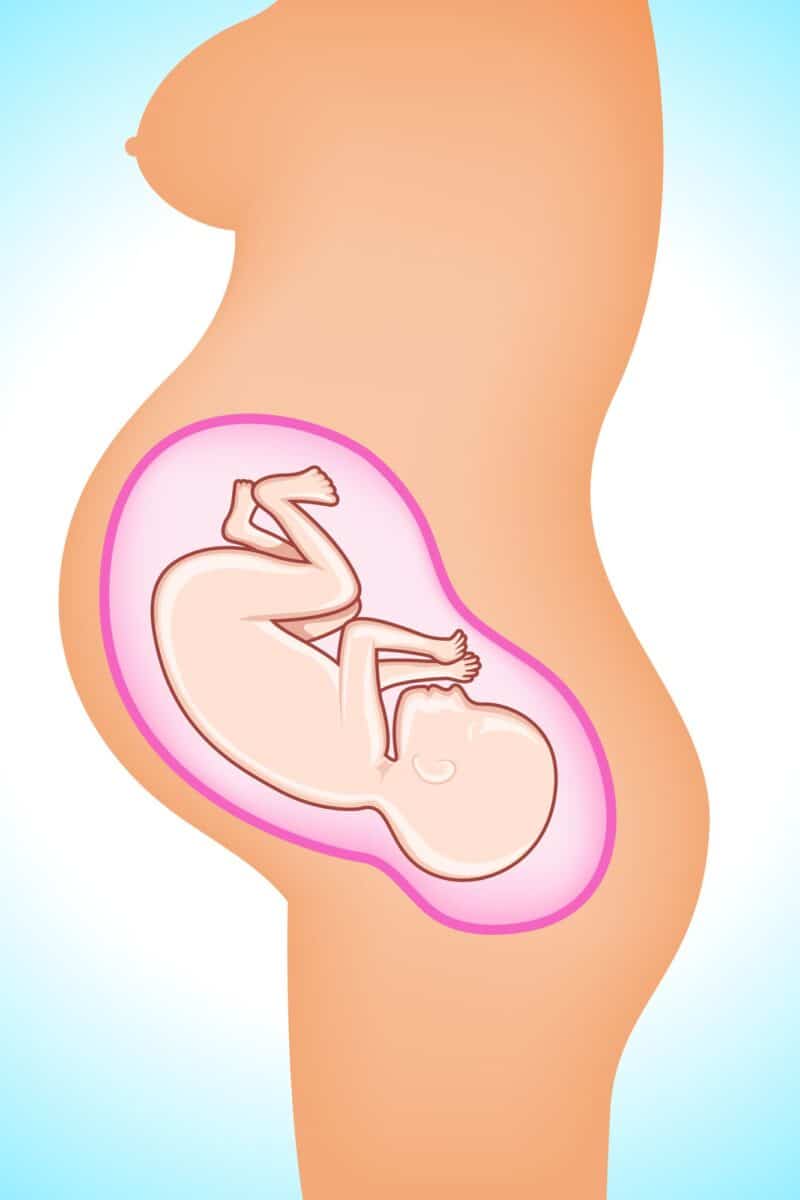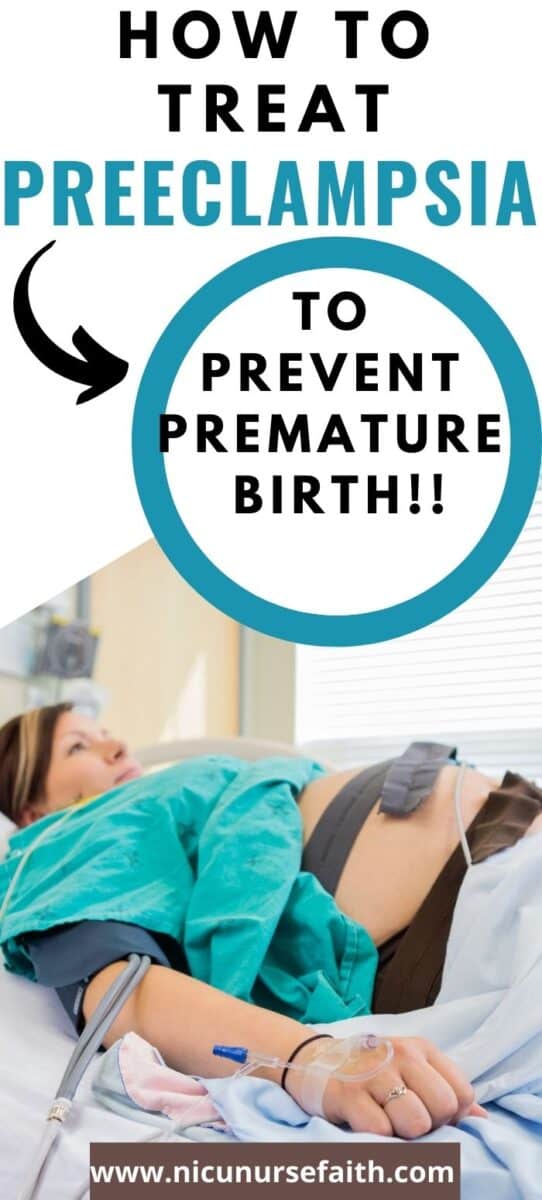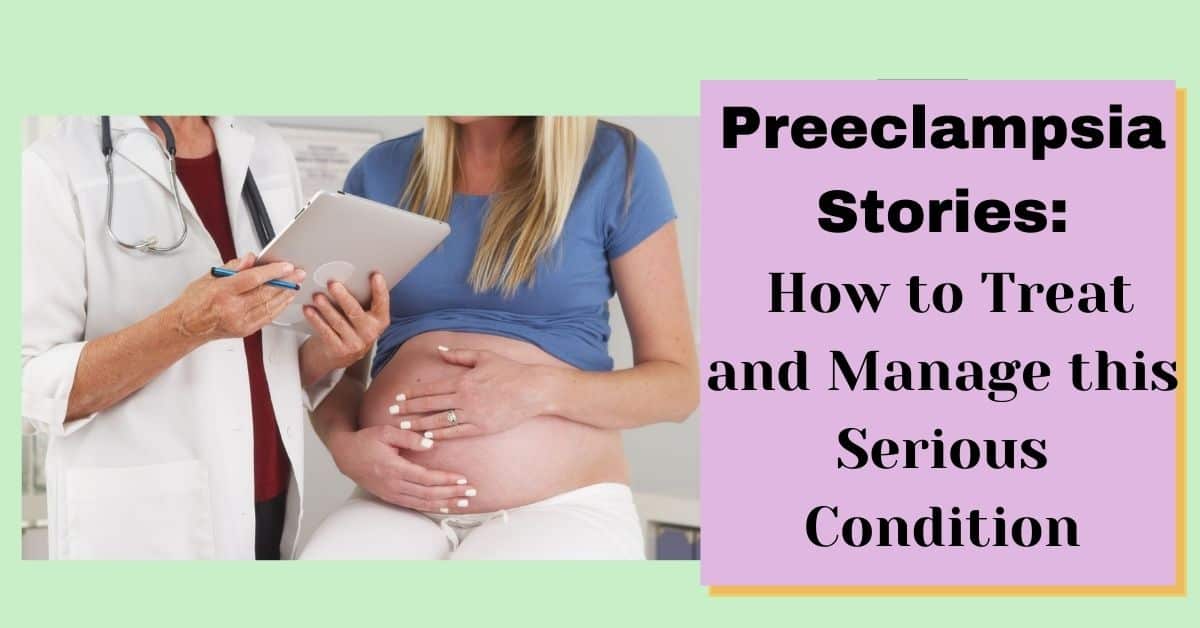The Guide in Preeclampsia Management and Treatment
Are you looking to learn more about preeclampsia because you currently have it or had it in the past?
I’ll be teaching and sharing my knowledge through 2 preeclampsia stories of patients.
The most important point to know is that it’s not your fault you got preeclampsia, but you should also be aware of the risk factors and how it can happen.
Also, there are MANY women who have no risk factors at all, and still get preeclampsia!!
Which leads to having a premature baby… so you are not alone (if this is the case for you!)
I’ll be sharing 2 preeclampsia stories and lessons on the management of this condition.
Everything in this post is what I teach the moms, in the NICU, who had preeclampsia and wanted to know more about it.
In this post, I will explain important risk factors and common symptoms, the treatment for it and the care of your baby in the NICU.
So let’s get started!

** This blog post is based only on my knowledge and experience as a nurse. This blog post is meant to be educational and information to increase your knowledge only. So always talk with your health care team if you have any questions/concerns with your pregnancy. Read my disclaimer if you have any questions.
Preeclampsia Stories
**I changed the details of the story and names to protect privacy
Story 1: Leah
Leah was a 25 yrs old newlywed.
She got married to the love of her life 6 months ago.
Both Leah and her husband were runners and loved to go on morning runs together.
Leah and her husband were excited when she found out she was pregnant.
This was her first pregnancy.
She was low risk and healthy overall.
She didn’t have any health issues.
Her whole pregnancy was going well and every test was normal, including her blood pressure.
Then at 27 wks, she noticed her hands and feet were swollen, more than usual, and she would get headaches often.
She just felt unwell.
That day, she went into the ER.
They took her blood pressure and it was really high!
They admitted her to the Labour and Delivery unit to do more tests.
All the tests showed that Leah had organ damage from the blood pressure being so high.
They did a scan on her baby and noticed that her baby was struggling inside too.
That is when the team decided, with the consent from Leah and her husband, to deliver.
Leah had a baby girl had 27 5/7 days.
The baby was rushed to the NICU to be stabilized.
After delivery, Leah’s blood pressure came back down, but she still needed to be on blood pressure medications for a couple of days.
Story 2:Halima
Halima and her husband were married for 10 yrs.
They have 4 kids, ranging from 2 yr-9yr old.
All of her previous pregnancies were healthy and she had no problems.
She was pregnant with her 5th child.
She is healthy overall.
All of her appointments were going well and all her tests were normal.
Halima recently celebrated her 33rd birthday and on the same day, she started to feel unwell.
Halima was 29 wks pregnant.
The next day, she had a routine ultrasound and they noticed the baby was measuring smaller than normal.
Halima also expressed that she wasn’t feeling well last night, so the nurse took her blood pressure at that moment.
Her blood pressure was really high and Halima was admitted to the hospital.
When she was admitted, the doctors started blood pressure medication right away.
She had routine ultrasounds and lab work almost everyday.
The first week of her hospital stay, they were able to stabilize her blood pressure and, based on her ultrasound, her baby was doing well and not stressed.
Therefore, delivery of the baby was not considered.
Halima was in the hospital for 2 wks and stable. After 2 wks, they noticed the ultrasounds were getting worse and the baby was stressed.
So the team decided to deliver the baby at 32 wks.

Preeclampsia Definition
Preeclampsia is really high blood pressure that leads to multiple organ damage, seizure or death, if not treated.
Eclampsia is when a mom with preeclampsia gets seizures.
No one wants eclampsia to happen (because it’s dangerous), so that’s why preeclampsia is treated very fast and hard.
Preeclampsia happens only after 20 wks.
Gestational hypertension also happens after 20 wks, but the difference is that there is no organ damage.
High blood pressure before 20 wks is known as chronic hypertension, which is high blood pressure that was there before pregnancy.
This is because, normally, blood pressure is lower in pregnancy, so any increase in blood pressure is abnormal.
Also, some moms can experience preeclampsia after giving birth. This is known as postpartum preeclampsia.
So this is why it’s very important to monitor the blood pressure of new moms, ones who had preeclampsia and ones who didn’t.
We don’t really know why preeclampsia happens…
but we know that it’s connected to the abnormal development of the placenta blood vessels early on in the pregnancy.
It consist of 3 factors:
- New high blood pressure for the patient: this includes 2 readings of blood pressure equal to or higher than 140/90
- Protein in the urine: a sign of kidney damage-normally there should never be protein in the urine
- Damage to the liver & brain ⇨increase liver enzymes in the blood, headaches-damage to liver leads to HELLP syndrome
HELLP Syndrome: It occurs in severe preeclampsia. The body is trying to repair itself because of the damage that happened. HELLP stands for:
H: HEMOLYSIS: rupturing of red blood cells. Red blood cells take oxygen and nutrients to tissues of the body
EL: ELEVATED LIVER ENZYMES: shows us that there is liver damage
LP: LOW PLATELETS: normally platelets stick together and stop the bleeding when you have a cut. —-> In HELLP, the body is sending platelets to help the injury, but the platelets start to stick together at the injury site. This causes a blockage of blood flow to the organ.

Preeclampsia Risk Factors
There are specific risk factors that increases your chance of getting preeclampsia.
But in my practice as a NICU nurse, I have also seen moms who have no risk factors that still get preeclampsia.
And these cases are the hardest ones to explain!
Therefore, getting preeclampsia is never your fault and you should never blame yourself!
The most important thing is that you are healthy and safe and your baby is safe, even if that means delivering early.
This is the only thing that matters!
⚡Risk Factors:⚡
- first pregnancy
- multiple pregnancies ex: twins or triplets
- Having history of preeclampsia or family history
- Age ( younger than 18yrs or older than 35 yrs old)
- having high blood pressure before pregnancy
- diabetes
- Obesity
In the above preeclampsia stories, Leah had the risk factor of first pregnancy, even though she was healthy and fit.
Her preeclampsia started after 20 wks.
Halima had no visible risk factors, but we are not sure if there was a family history of preeclampsia.
Halima’s baby had the common sign of a baby not growing because preeclampsia affects the placenta and the baby’s growth.
Also I wanted to point out that Halima didn’t deliver right away.
This is because her blood pressure was better controlled with medication, her symptoms were stable and her baby was not in distress.
She was able to go to 32 wks.
This is important for all moms to know – you don’t have to deliver right away with preeclampsia if your symptoms and baby are stable.
Always talk with your health care team regarding your pregnancy and your plan of care.
Preeclampsia Symptoms
The common first symptoms are high blood pressure (” feeling unwell”), swelling of hands and feet, sudden weight gain, headache and nausea/vomiting.
Signs and symptoms of preeclampsia are:
- High blood pressure
- Protein in the urine
- Swelling: increased swelling to hands, arms and legs, increased weight gain
- trouble breathing
- headache
- vision problem
- abdominal pain
If you are past 20 wks, and you have any of the above symptoms or just feel “unwell”, go to the hospital ASAP!
Untreated preeclampsia can lead to major and dangerous health problems such as placental abruption ( placenta separating from the uterus), clots forming all through the body, stroke, seizure or death.

Preeclampsia Treatments
Delivery is the best cure as the main problem causing the preeclampsia is the placenta.
If you are greater than 37 wks pregnant, there’s a high chance the health care team will decide to deliver the baby.
If your are less than 37 wks pregnant, the doctors will try not to deliver as long as
- your blood pressure is stable with medication
- your symptoms are stable and
- your baby is not in distress
Until then, they will give you medications to bring your blood pressure down,
but if the blood pressure is not decreasing and your symptoms are not improving….
then the last resort is to deliver your baby to protect your life and your baby’s life.
The treatments that are often used are:
- Magnesium: to prevent seizures and to protect the baby’s brain
- It’s given before birth, during labour and 24 hrs after birth
- Many women feel sick while on magnesium, talk with your health care team if you have any concerns while taking magnesium
- Blood pressure medications
- Corticosteroid: these shots will help mature your baby’s lungs faster, so they have a better outcome in the NICU
- It’s 2 shots— it’s best for your baby to get both shots before delivery
- This is why magnesium is given, so the pregnancy is prolonged to have time for the mom to receive 2 steroid shots.
NICU Care of your Baby
The NICU care depends on how early the baby is born.
With preeclampsia, many of the babies are born really early and small.
If your baby is born greater than 28 wks, some of the below interventions will apply, but they won’t be as intense since your baby is bigger and more stable.
NICU care is as follows:
Breathing: the lungs are underdeveloped, so the baby needs help with breathing. This can be:
- Intubation (breathing tube in the mouth) with ventilator breathing for them
- CPAP – mask on nose that provides high pressure to keep the lungs open, so the baby can breathe on their own.
Temp: Small babies are in high temperature isolettes with high humidity.
The high temperature keeps the baby warm, so the baby can focus on growing.
Depending on how small your baby is, the skin can be very thin, which causes them to lose water through the skin. The humidity in the isolette and the extra fluids given decreases the amount of water lost.
IVH: the health care team does as much as they can to decrease the chance of an intraventricular hemorrhage (brain bleeds).
In babies born less than 28 wks, the blood vessels in the brain are soo fragile, so we have to be very careful with the medications and fluids we give to not cause a bleed.
The health care team is always weighing the option between benefit vs risk with any treatments given to our very small premature babies.
Blood pressure: Having a stable blood pressure is so important to make sure important organs, like the brain, have enough blood going to it.
So if the blood pressure is low, medications are started to stabilize the blood pressure.
Fluids: premature babies need lots of fluids and nutrient, as they are losing fluid through their skin.
They also need fluids to stabilize blood glucose levels, get extra proteins, electrolytes and fats to grow.
Infection Prevention: Premature babies are born so small and fragile. Also their immune system is immature and hasn’t fully developed yet. So to protect them, everybody, who comes in contact with any premature baby, has to wash their hands well and wipe down any items coming into the NICU.
Preeclampsia Prevention
Once you get preeclampsia, the chances of getting it again is higher.
But there are steps that can be taken to decrease the risk.
These interventions are the most common practices in Canada.
Speak with your health care team in your country on the best practice to decrease the chance of preeclampsia returning.
Interventions includes:
- losing weight (if you are obese)
- controlling your blood pressure and diabetes better
- ideally spacing out your pregnancies, 2 yrs apart but not less then 10 months.
- the American Pregnancy Association also offers other non medical actions you can take to decrease the chance of preeclampsia.
For Medications:
- starting Aspirin really early in pregnancy (b/w 10-12 wks). Aspirin is known to help prevent preeclampsia in many women.
- taking adequate calcium and Vitamin D
Final Thoughts on Preeclampsia Stories and the Condition Overall
Preeclampsia is a very serious condition in pregnant women.
So it is very important to know the risk factors and the symptoms, so you can monitor yourself.
Also, some women might still get preeclampsia AFTER they have given birth, so never forget that!
This includes women who didn’t have preeclampsia in their pregnancy.
This is why your midwife or doctor monitors your blood pressure at your baby’s first appointment at the clinic.
If you are worried about your current pregnancy or future pregnancies, always talk with your health care team about your concerns.
If anything on my blog has helped you, please make sure to share the post, comment below the post and subscribe to my email list for more goodies.
I would love to hear from you!
Instagram: @nicunursefaith
Pinterest: nicunursefaith
Related Articles on Preeclampsia Stories
Have you ever had Preeclampsia? What were your early symptoms?
COMMENT BELOW


